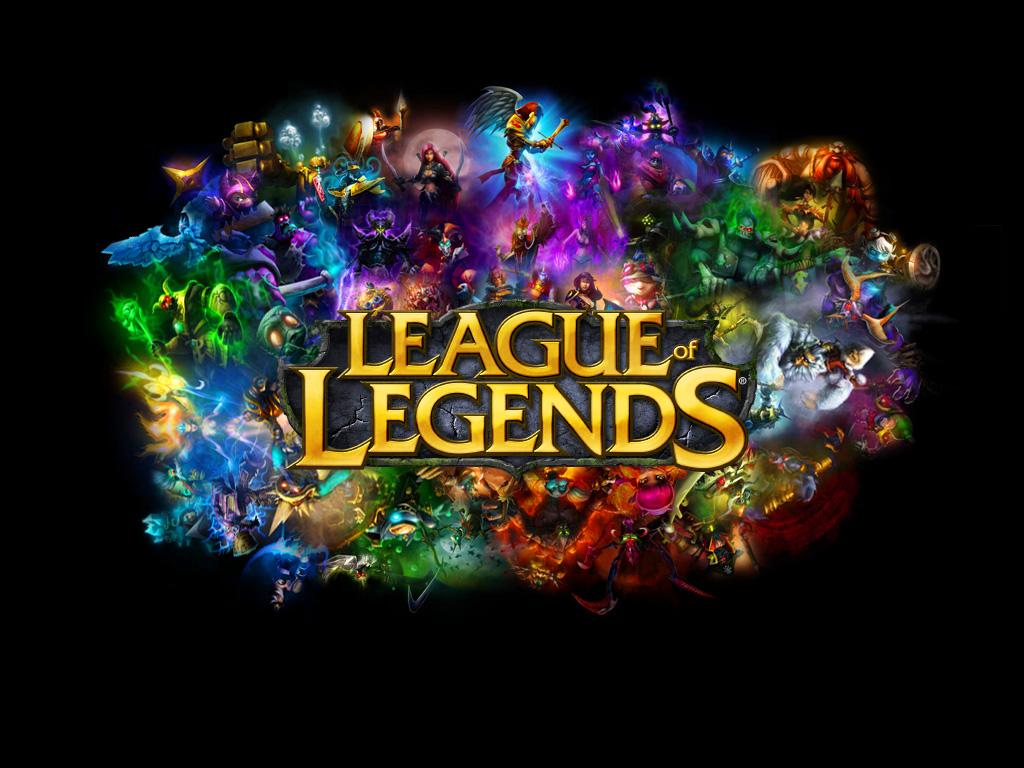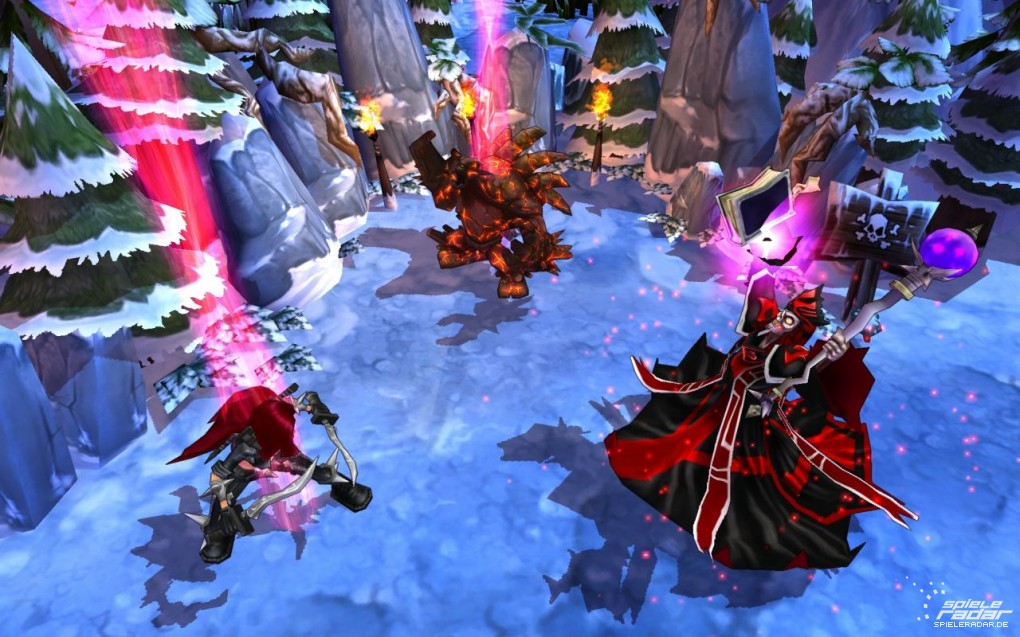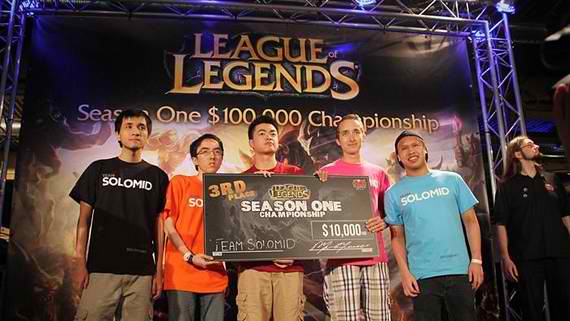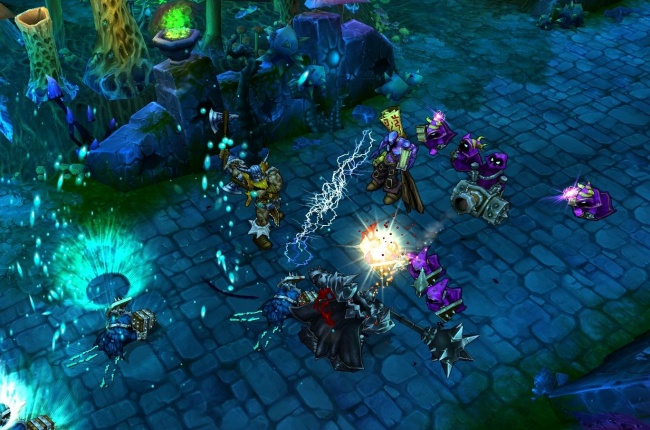By Steve Fowler
Following in the series looking at digital games and the rise of Publisher 2.0, where we last showcased the growing opportunity for mid-core games, we turn to the one of the category’s biggest games. League of Legends is arguably the most successful free-to-play mid-core title in the digital game market. The game’s publisher Riot Games is a rising star that’s helping define what it means to be a Publisher 2.0.
League of Legends began as a small community focused PvP game inspired by the popular “Defense of the Ancients” mod based on Warcraft III. The game has players choosing sides to defend and attack cooperatively against other real players. The matches are furiously fast. They’re also extremely well balanced, a critical element for a free-to-play PvP game. Players get in, get their fix, and then reset or stop playing. It’s exactly the type of play style that suits mid-core gamers.
Riot’s success with making the game a hit also has a lot to do with how it branded the IP with core gamers in mind and focused on nurturing a loyal player community. League of Legends has an impressive 32 million players registered, but what’s astounding is how more than a third still play monthly, and more than 4 million do so daily. That’s dedication that comes with attracting core players, and it speaks to both the quality of the game and Riot’s player community, which drive the experience.
For anyone who wasn’t tracking the rise of digital and free-to-play a few years ago, Riot’s success may have been off the radar. That changed in 2011, when China game conglomerate Tencent invested a majority stake in the company to the tune of $400 million. It didn’t go to Riot’s head. There was no sudden surge in marketing spend, no chase for the quick buck nor expensive and unsustainable customer acquisition campaigns. Instead, the company continued its “community first” approach.

No small part of the credit for that philosophy, not to mention the overall success of League of Legends, goes to Chris Enock. Enock joined Riot’s marketing team just as League of Legends was exiting beta testing in 2009, and he now serves as senior marketing director.
“We haven’t yet had the time to focus on traditional acquisition marketing, of going big at retail, or doing massive media buys on TV,” says Enock. “Instead we focus on helping our players engage with the game and the brand. That has been our primary strategy for both [player] acquisition and retention.”
Enock granted [a]list daily this exclusive interview to delve into what he believes defines effective marketing strategy for digital games and how Riot understands the changing face of game publishing.
Steve Fowler: Tell us, what do you oversee at Riot?
Chris Enock: I oversee a number of the publishing operations at Riot Games including Business Intelligence, Marketing, Community, eCommerce and Corporate Communications.
Steve Fowler: League of Legends is an entertainment service and not a traditional game product, given that it’s persistent, constantly evolving, and reliant on an ongoing stream of customers. How does that simple fact change the way you market it?
Chris Enock: I think it changes things drastically, but in a way that plays to our strengths.
First, I love marketing video games, not only because I get to play League of Legends and other titles in the name of “work,” but also because it’s a high involvement product. Gamers who play the types of games I most enjoy working on are highly involved in the games they play. They play a ton – most League of Legends players invest hours in the game each week – and that means they’re highly knowledgeable about the games they play. They research strategies, debate the meta-game, and even create astounding fan art. That gamers dedicate so much thought to the games they’re playing makes marketing games more interesting than marketing products like butter or socks that consumers might only take a few moments to consider.
That level of engagement and passion enables us to have a different type of relationship with players. Instead of just broadcasting a marketing message or talking at them, we talk with them, typically on our forums or on social channels like Facebook. We might start a conversation, but it very quickly becomes a real live conversation between players — a different beast entirely. Traditional marketing, like a TV commercial, allows marketers to broadcast messages and doesn’t generally offer a response mechanism. Exaggerated claims aren’t necessarily challenged. In contrast, marketers who engage in conversation with players must be authentic or players will respond negatively, challenging the marketer’s message and drowning it out with their own corrections or questions. For League of Legends, that means we only do marketing around messaging we feel will both resonate with and ring true to our players.
Steve Fowler: Let’s look at the three types of media, paid media such as ads, owned media such as videos and game assets, and earned media such as PR, social and community. Give us insight into how Riot Games uses these effectively and how you integrate your message into each.
Chris Enock: Our team of marketers takes Riot’s mission to heart: We try to be the most player focused company in the world. This means we focus on building our brands from a player perspective. Building our brand then becomes an exercise in deeply understanding what players want, aligning with development around providing it to them, then connecting the dots for players so that when they taste the improved experience they understand it wasn’t accidental. The net impact is that our players end up doing most of our marketing for us — what you’d call earned media in your framework. Most League of Legends players join because they hear about the game from a friend. Friends feel comfortable telling friends about the game because they see Riot’s regular improvements to the game experience. The medium for communicating our message – as in paid media or owned media – is in some ways an afterthought. We just want to have a meaningful dialogue with our players about the game.

Steve Fowler: In your marketing messaging, you almost see no mention that League of Legends is in fact free-to-play. Is playing up that business model no longer a focal point for your company’s strategy?
Chris Enock: That’s very insightful. Nobody plays League of Legends just because it’s free. There are plenty of games like that that don’t really grab and hold players’ attention. They play it because it’s a compelling game with a great roster of characters. Being free just makes it easier for players to get into and stay in the game. So instead of the economic model, when we discuss the game, we focus on what draws players to the game. We try to grab the attention of players by showing the iconic and epic characters. As players engage, we try to convey the action-oriented nature of the game. As gamers explore deeper on the website or elsewhere, we discuss the strategic depth of the game.
Steve Fowler: eSports seem to be a huge focus for you. Tell us how this works into your overall marketing strategy.
Chris Enock: It’s a big part of our being player-focused. We designed the game to be a viable eSport from the beginning, but when saw how important competitive play was to League of Legends players, we doubled down. There were well more than a million players tuning in to our first World Championships in 2010, and [we] have seen more than two million tune into the regular matches in our Challenger’s Circuit this year. We look at eSports, in marketing parlance, as a way to deepen our engagement with our players. That millions of gamers watch other people playing the game for hours speaks volumes about the role League of Legends plays in their lives. This is another area where our interests and those of our fans intersect. Having a lot of exciting competitive play in [the game] lends itself to great conversations, and therefore great marketing around it. It’s the equivalent of Monday morning water cooler conversations about the performance of your favorite sports team over the weekend. eSports fans have huge levels of engagement.

Steve Fowler: Can you give us some examples of what tactics are working best for player acquisition and retention?
Chris Enock: To add to the earlier answers, for retention, we don’t focus on “retention” per se. We instead focus on making sure that players have a good experience in the game. A popular tactic of retention marketing is the winback campaign, usually an email to lapsed customers. We don’t think that sort of thing is effective unless players find that the gameplay is well balanced, that matchmaking works well, that a culture of team collaboration exists, and so on. We have had to build our organization from the ground up to run the game as a live service, with content, balance and new feature updates very frequently. It has required a different structure and a lot of different choices from what more mature or older-school businesses do, but I believe that much of the industry will eventually have to make a lot of the changes and tradeoffs we’re making at Riot Games.
In terms of acquisition our players do a lot of the marketing for us. They tend to carry the message to other potential players and bring them into League of Legends. We enable that by having a conversation with our players, by discussing and getting behind aspects of the game that they will support and believe in. In that sense, we are tailoring our marketing messaging not to new consumers, or targets, but instead to our current base of fans.
We haven’t yet had the time to focus on traditional acquisition marketing, of going big at retail, or doing massive media buys on TV. Instead we focus on helping our players engage with the game and the brand. That has been our primary strategy for both acquisition and retention.
Steve Fowler: What’s your opinion on the importance of building a brand around a game, and how did you approach it with League of Legends?
Chris Enock: I think building a brand is essential, but we don’t go about it the conventional way. In traditional branding, money is spent on paid media to help a symbol start to take on a set of attributes that mean something for consumers. The Nike Swoosh, thanks to the endorsement of Michael Jordan and Tiger Woods and a whole string of celebrity endorsers and Super Bowl commercials, certainly is an amazing brand. But for League of Legends, we’re taking a more grassroots approach, instead allowing the experience of playing to define the brand for players. When someone has an amazing moment in game, there’s a deeply rooted sort of goodwill generated, and we think it’s more valuable.
Our job as marketers is to simply to highlight the highlights, to help the community become aware of the rich stream of value that’s being generated by Riot [such as] features, service upgrades, new champions, new skins, and by the community itself – team play, community-generated art, community-generated strategy guides, and so on.
Steve Fowler: What advice can you give to marketers of smaller digital games with limited resources and budgets?
Chris Enock: The great thing about this new style of marketing is that it doesn’t really cost anything compared to traditional marketing around paid media. Many of our conversations happen on our forums, Facebook, and other social channels. The reach and frequency of this marketing first scales with the strength of the play experience and value offered, and second with the number of players in the game. It’s also a virtuous cycle. Companies that better engage their players around the positive aspects of their game enjoy more positive word of mouth and more referrals.
As for jumpstarting the process and getting the word out about a game at launch, there are a number of marketing channels available today, like AdWords and Facebook, where the limiting factor is more often time and creativity vs. budget. Having a two-way conversation with players flips the tables. Now, the quality of the messaging is as important as the ability to broadcast it.

Steve Fowler: With a service-based game, the marketing really begins at the launch of the product. Can you give us an idea on how you manage the consumer message over time to keep it fresh and relevant?
Chris Enock: Being fresh and relevant means having meaningful discussions with players. League of Legends is built and run around being able to facilitate that. We update the game on a rapid cadence, adding new features, new content and balance changes about every two weeks. That cadence creates a constant dialogue with players who are excited and engaged not just to play but to talk about it as well. Add in eSports, contests, events and many other activities that Riot helps facilitate, and there’s always something new happening.
The strategic challenge then becomes more about shaping the brand by prioritizing which areas you want players to talk about, rather than as is typical coming up with a clever marketing message to get people excited about something they normally wouldn’t pay attention to. My personal challenge is around recruiting great marketing talent who can think about how to leverage this shift in marketing and understand the messaging nuances enough to sustain a conversation with our most hardcore players. When players are engaged, and new game enhancements roll off the line with regularity, keeping the conversation fresh and relevant is straightforward.
This interview is part of a series of articles for [a]list daily outlining the changing face of publishing and marketing games on digital platforms. The series began with “Why Publisher 2.0 is M.I.A.” Subsequent pieces have covered the shift in digital games from marketing a product to marketing a service, a publisher that gets the category in an interview with Wizards of the Coast, and a piece co-authored with Peter Warman, head of analyst firm Newzoo, looking at the growing opportunity in mid-core games.
—
Steve Fowler is a thirteen year veteran of the interactive entertainment industry. He is responsible for the brand identity and launch of the Halo franchise at Microsoft Corporation, Inc., and has held marketing and business development roles at Interplay, Sega Sammy Holdings, Inc., Square Enix, Inc., and Take-Two Interactive Software, Inc. He is the chief architect of the one of its kind annual industry conference the [a]list summit, and has been incubating new digital game publisher [a] list games internally at Ayzenberg Group for the past year. For more information on [a]list games, visit www.alistgames.com.

